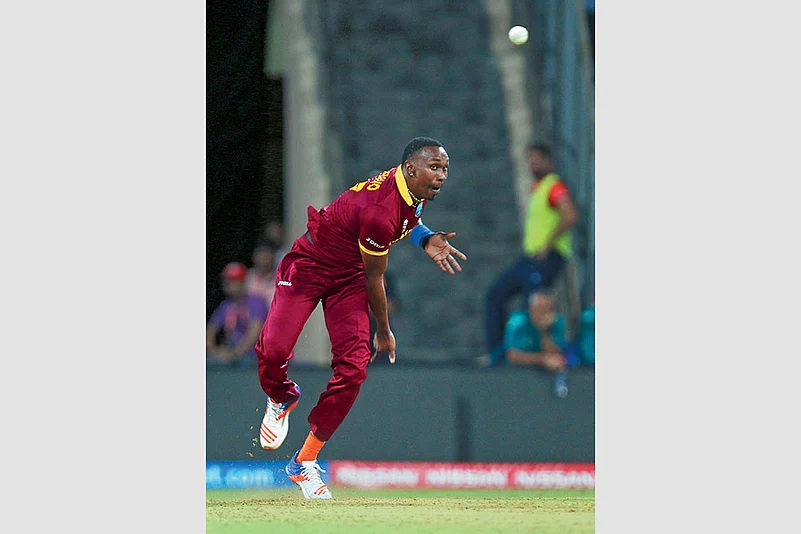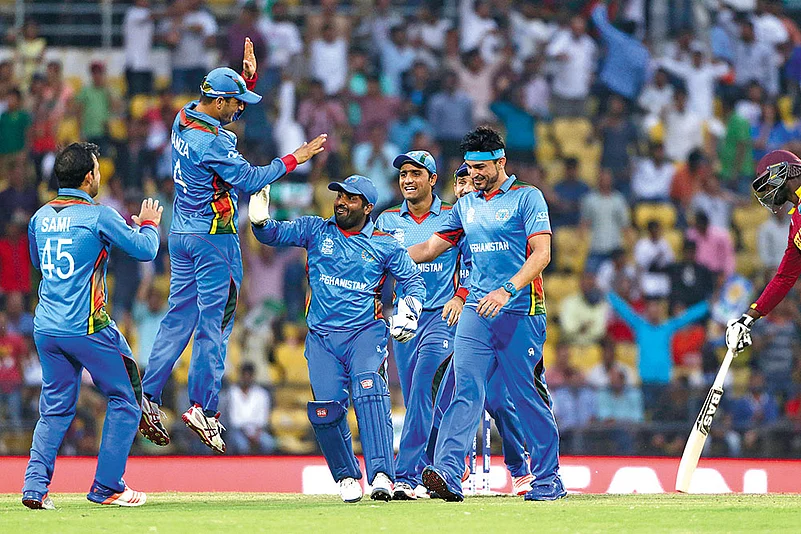It gave us the cache of sporting memories one demands of any good tournament—images and moments one can recall years later, some superlative performances, heart-rending stories, the unpredictable blend of passion and method that makes cricket what it is. But the ICC World Twenty20 will be most remembered for the surprises it threw up—the counter-intuitive trends it firmed up. The dominance of spin and, overall, a reliance on slow bowling techniques by even pacers. Asian teams had a curious run: a forgettable show by the old guard, barring India (till their shock loss in the semis); and at the other end, the emergence of minnows—not Bangladesh, but Afghanistan. Here are five takeaways from the tournament:
Slowly Does It
It wasn’t as if standard-issue pace was out: Mohammed Amir steamed in his balls like poison darts, and Ashish Nehra cut and swung like the old days, probably better. But a lot of fast bowlers relied heavily on clever, subtle pace variations, a lot of them in the slower range. Speedsters from various teams bowled a variety of deliveries—back-of-the-hand, front-of-the-hand, slow cutters—to lure batsmen into playing wrong shots on slow and low pitches.

Slow Train Dwayne Bravo gets one to curl in lazily, sneakily at a bat. (photograph by AP)
Aussie speedster James Faulkner, Mustafizur Rahman of Bangladesh, India’s Jaspreet Bumrah, Dwayne Bravo of West Indies and a few Sri Lankan pacers, to name just a few, employed this tactic quite successfully. Faulkner, in particular, has mastered this art and deployed it with telling effect. Against Pakistan in Mohali, the lanky 25-year-old bowled an extraordinarily high tally of 16 slow balls out of the 24, which is two-thirds of his four-over quota! What’s more, he snared four of his five wickets (5-27) off such deliveries in that match. Overall, Faulkner bagged eight wickets in four matches at 13.25.
His team-mate Shane Watson also used this tactic with success. His dismissal of Rohit Sharma in the virtual quarter-final against India was one such instance. In the same encounter, Virat Kohli was beaten only twice in his epic 82-run knock and on both occasions it was against pacer Nathan Coulter-Nile’s slower balls. Earlier that evening, rookie pacer Bumrah had cleaned up Glenn Maxwell with a slower one (though in the semis, he showed he could go the classic way too as he beat Chris Gayle for pace, getting him with a classic low swinging full toss). Mustafizur was perhaps the best of this lot. He finished with nine scalps in three matches (as Bangladesh crashed out early), but flummoxed many other batsmen with his natural skill.
Says former India Test opener Abbas Ali Baig: “The pitches were a little on the slower side and the ball was stopping and coming. When you bowl short, more often than not batsmen go for a pull or hook. (But if) the ball stops, turns a little—leg break or off break—it confuses the batsman. A dot ball is on the cards every time they do that.”

Watch That Wrist Kiwi leggie Ish Sodhi scalps one of his total eight. (Photograph by AP)
And The Pitch Turned
Cricket had anyway become a batsman’s game and the T20 format favours them all the more—usually, flat pitches are laid out to further encourage batsmen to play those crowd-pleasing big shots. Bowlers are meant to be at the receiving end almost all the time. But Indian curators sprang a surprise by producing spin-friendly pitches at a few centres, particularly Nagpur and Calcutta. There was hushed talk that the pitches for India matches were prepared especially on instructions from the home team to suit Dhoni’s boys. But after India got a taste of its own medicine (read spin) in the first match in Nagpur, having been bundled out for 97 by New Zealand while chasing 127, the criticism grew.
Coach Sanjay Bhardwaj, who polished Gautam Gambhir’s game among others, says it pointed to a dichotomy in strategy: “If you have confidence in your batting line-up, which is India’s strength, you should make pitches that suit it. Instead, we seem to be making pitches for our bowlers, actually spinners. It appears that somewhere there’s some confusion.”
A top administrator of a state association where the pitch came under scrutiny for being spinner-friendly sought to deflect blame. “This problem of slow pitches is everywhere now. It’s because of atmospheric changes etc. We are also puzzled why it’s happening,” he admits, requesting not to be named. “In Nagpur, the India-NZ match was played on the centre pitch. The Calcutta pitch was more horrible; it turned so much. Because India won that, nobody pointed that out.” Citing Sunil Gavaskar, he says it’s the batsmen who failed to adjust to local conditions at Nagpur. “But we don’t know what the problem is; the average total [in the league phase] was 130-140.” As in, not very different from the 149.95 averaged in all the 20 league matches together.
The Leggie Takes It
Logic dictates that leg-spinners should be seen as a luxury in T20. Being a more difficult art, they traditionally have more trouble over control, and here there’s little margin for error. But, paradoxically, their armoury of flight and spin variation has proved to be a more difficult thing for batsmen to handle, especially in crunch situations, where they would like nothing more than predictability from a bowler. This tendency has been already visible, with KKR winning two IPL titles largely on the strength of West Indian Sunil Narine’s guiles (which don’t seem to work as well for him in longer formats). In WT20, this trend came into full bloom: leggies emerged like a whiff of fresh air, playing crucial roles for their respective teams. The pitches didn’t harm their cause either.

Going Bust The downcast look is what Pakistan wore mostly at WT20. (Photograph by Sandipan Chatterjee)
Their show in the league phase throws up quite a heart-warming statistic. The wicket-takers’ list shows Afghanistan’s teenaged Rashid Khan placed at number two position with 11 scalps, just one wicket behind his team-mate and off-spinner Mohammed Nabi. Behind the 17-year-old Rashid, there ranged a number of practitioners of this black art: New Zealand’s Ish Sodhi (8 wickets in 4 matches), West Indian Samuel Badree (6 in 4), Imran Tahir of South Africa (6 in 4), and Aussie Adam Zampa (5 in 4), besides Adil Rashid of England and Pakistani captain Shahid Afridi.
Legendary spinner Bhagwath Chandrasekhar is happy that his breed is flourishing in the shortest format. “These days all the spinners are doing well. Of course, anybody can do anything. But they must be good at it,” the 70-year-old told Outlook. He acknowledges the role pitches played, but gives full credit to the skill of the bowlers. “To some extent, the wickets might have helped them. But you have to appreciate it; they utilised it.”
The Afghan Princes
Theirs was perhaps the most heartening story of the tournament. The team from the terror-hit land crossed several tough hurdles en route to winning hearts and accolades. They first qualified for the first round from a global competition, then continued the good run in the qualifying round in India. Here, they were the only team of the eight that won all three matches—including the win over Zimbabwe—to earn the right to lock horns with the established powerhouses in the main round.
They went on to upset the West Indies in the tournament proper to provide further evidence of their potential—and came close to beating England, who have reached the finals, and Sri Lanka, but inexperience let them down. Afghanistan trained in Greater Noida and Sharjah—an Indian and a Pakistani played a hand in their preparation. The presence of former Pakistan captain Inzamam-ul-Haq as head coach and former India pacer Manoj Prabhakar as bowling coach was quite crucial. Prabhakar, who has worked with Afghanistan’s under-19 players too, has high hopes from them. “We have a very good team, potentially. If I get to work with them for a year, I can help them beat any team. They have very good up-and-coming under-19 players,” Prabhakar says.
On Inzamam’s role, he says: “He is a father figure to the players and his words carry a lot of weight. His impact on the team has been very good.” Prabhakar is now looking forward to Afghanistan’s upcoming ODI series against Pakistan.
Among the performers, Mohammed Shahzad (222 runs in 7 matches), captain Asghar Stanikzai (141 in 7), Noor Ali Zadran (124 in 6) and Samiullah Shenwari (122 in 7) excelled with the bat. And of course, offie Nabi emerged as the top wicket-taker among all countries with 12 and leggie Rashid Khan was just one wicket behind him—and with a good economy rate.

Earthquake? Faf du Plessis takes a good look at the Nagpur pitch. (Photograph by AP)
The Asian Puzzle
Barring India’s run to the semis, where the Windies took down their pride, the old Asian teams fizzled out way before that stage. Defending champs Sri Lanka (who had beaten India to win in 2014), Pakistan and Bangladesh have different reasons to show for their middling to abysmal performances. In a way, Sri Lanka let down its fans the most since they were the reigning champs though, to be fair, this was a team still coping from the loss of Mahela Jayawardene and Kumar Sangakkara—and the absence due to injury of ‘death bowling’ master Lasith Malinga. But a tally of three losses in four matches, with a solitary win against fledgling Afghans, was too stunning a fall from its peak.
The Afridi-led Pakistan was no better. Controversies dogged them through their stay in India, and probably that affected their on-field performance. Their solitary win over Bangladesh was the lone bright spot in their campaign.
“Both Pakistan and Sri Lanka made a lot of mistakes, like in team selection and the batting order,” says former India captain Bishan Singh Bedi. “In very simple language, I’d say Pakistan and Sri Lanka were only participating, not competing. Bangladesh were brilliant in patches but, overall, not up to the mark.” Bangladesh’s report card was so abysmal that it turned out to be the only ICC full member country that failed to win any of their four matches. Their consolation was giving India a run for their money, but in a tense last over they succumbed to pressure, made silly mistakes and ended up losing the game by a run. In a nutshell, both batsmen and bowlers let down Bangladesh. But it’s still a team on the cusp of better days—with good wins and fights in other formats of late. Not so with Sri Lanka—an established team needs to have planned for the exit of greats (Sanga and Mahela retired from T20 after the 2014 triumph). “They never looked like trophy holders. They looked very pathetic and miserable,” says Bedi.
















